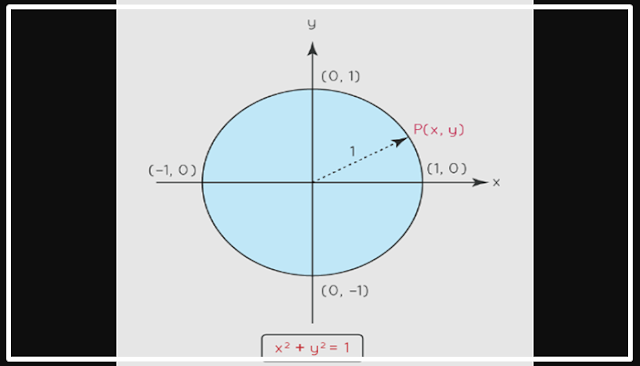When starting to learn trigonometry, the unit circle is one of the first things you learn. A circle with a radius equal to one unit is known as a unit circle. The cartesian coordinate plane often depicts the unit circle. The unit circle can be expressed mathematically with variables. The second-degree equation with two variables x and y are commonly used to express unit circle. The sine, cosine, and tangent values can be determined using the unit circle, which has uses in trigonometry.
Equation of a unit circle
A circle with a center (a, b) and a radius (r) is represented by the general equation (x - a)2 + (y - b)2 = r2. The equation of a unit circle is represented by this circle's simplified equation. With its center at (0, 0), the coordinate axes' origin, and a radius of 1 unit, a unit circle is created. Thus, (x - 0)2 + (y - 0)2 = 12 is the equation for the unit circle. The equation for a unit circle is obtained by simplifying this.
x2 + y2 = 1 is the graph equation for a unit circle.
The radius of this unit circle is one unit, and its center is at (0, 0). All of the points on the circle that are located in the four quadrants can be satisfied by the equation above.
Unit circle definition of trigonometric functions
With the help of the unit circle, the trigonometric function can be determined for the principal values. If the radius of a unit circle, with its center at (0, 0), is inclined at an angle of and its endpoint at (x, y), then cos(x, y) and sin(x, y) are the corresponding values. Furthermore, using these two numbers, all other trigonometric ratios can be derived. Additionally, the principal values can be calculated by modifying the value of θ.
Finding sin and cos using the unit circle
You can calculate or find the values of sinθ and Cosθ using the unit circle. Consider a radius with an endpoint at (x, y) and an angle of the positive x-axis in a unit circle with a radius of one unit and a center at (0, 0). A right-angled triangle with the radius as the hypotenuse is formed by drawing a perpendicular from the end of the radius to the x-axis.
This triangle's adjacent side is its x value, its opposite side is its y value, and its hypotenuse is one unit long. You can find sinθ and Cosθ using the trigonometric ratio formula: sin = Opp/Hyp = y/1 and cos = Adj/Hyp = x/1. So, sin = y and cos = x are the results obtained using these references.
The terminal point on a unit circle
The unit circle equation, x2 + y2 = 1, can be used to determine a unit circle's terminal point. The given point is a point lying on the unit circle if it fulfills this equation. Additionally, the values of cosθ and sinθ can be used to determine the unit value's terminal point.
Final thoughts
Trigonometry makes extensive use of the unit circle. The primary angle values of 0°, 30°, 45°, 60°, and 90° for the trigonometric ratios of sinθ, cosθ, and tanθ can be simply determined using the unit circle. Lastly, to calculate the standard angle values for each trigonometric ratio and to represent integers in the argand plane, a unit circle is helpful.

No comments:
Post a Comment